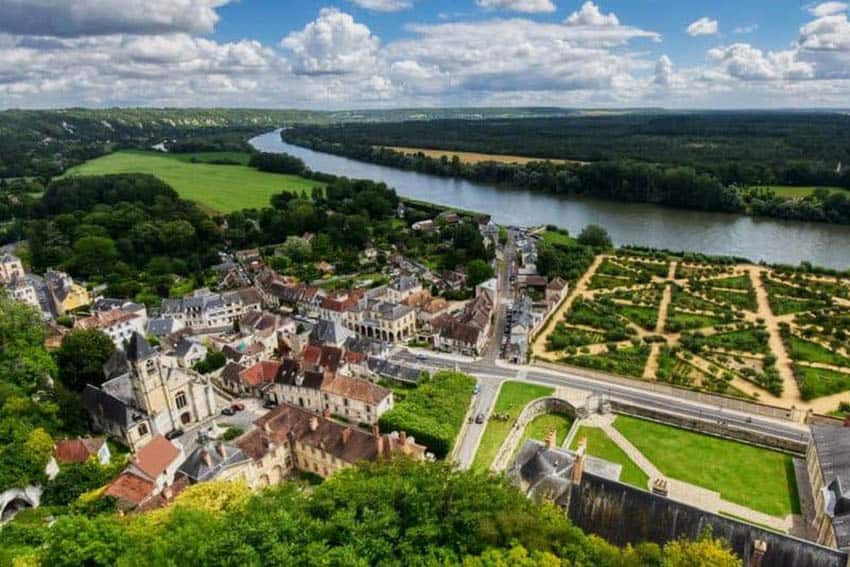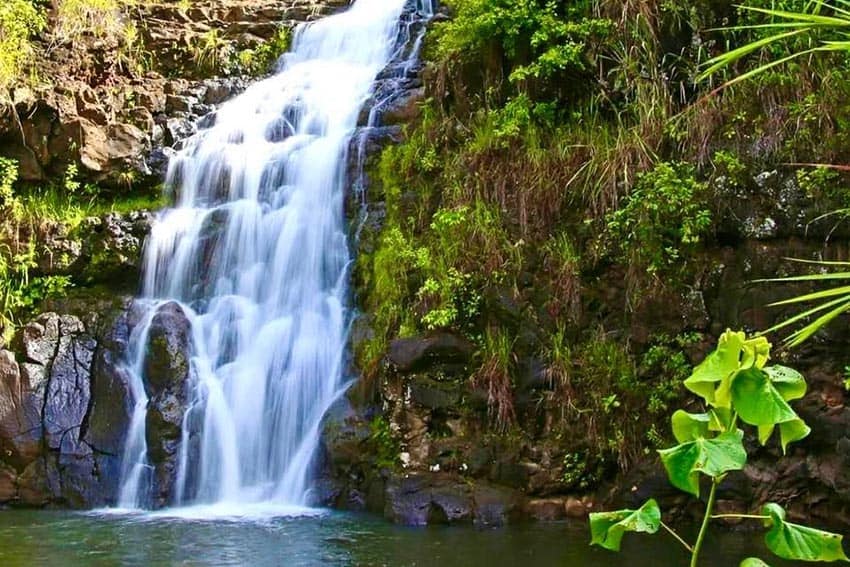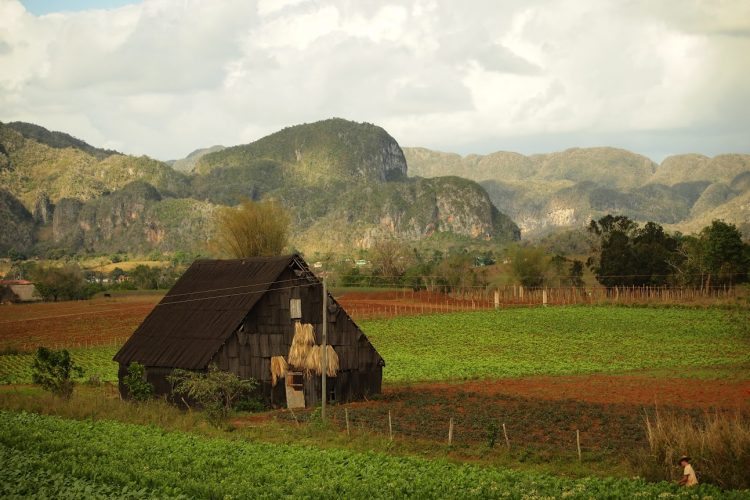
Rural, Beautiful Viñales, the Shangri La of Cuba
By Habeeb Salloum

“You’re lucky! I never did get around to visit Valle de Viñales. They tell me it’s Cuba’s Shangri-la!”
A Canadian acquaintance that I met in Havana seemed jealous when I told him that I had joined a group leaving the next morning for this same valley often on the tourist agenda.
“I’ll send an e-mail and tell you all about it when I return home”, I laughed as I bid him adieu.
I had enjoyed that trip so much that some years later I had returned to re-explore this renowned valley.
The next morning with the help of the soothing Havana spring breezes I felt elated as our bus set out on our journey to Complejo Las Terrazas then Valle de Viñales, a World Heritage site located in the western Cuban state of Pinar del Río.
Our objective this day was to explore Complejo Las Terrazas, a mountainous biosphere reserve then go on to tour the Valle de Viñales – considered by travelers as the most beautiful region in Cuba.
The Dream Valley of Cuba
My expectations were high as we drove westward from Havana on a four-lane highway. The fertile and affluent looking countryside kept us company as we made our way westward from Havana. I had a feeling of elation thinking of the ‘dream valley of Cuba’ that impressed me so much during my first trip to this part of the country.
After about 70 km (44 mi) we reached the Las Terrazas complex – a rural community of sustainable development.
Our first stop was at the Moha Hotel, located on the edge of the village of Las Terrazas and the center of the leisure industry in the region. Entering the swimming pool area we were greeted by schoolgirls offering us souvenirs while a band played rousing Cuban music.

Soon we were sipping our drinks while being caressed by the cool breezes flowing through the surrounding tree-covered hills – home to some 900 species of plants, among which are 29 types of orchids, and some 120 bird species.
Sustainable Development
What has helped in making this all-encompassing greenery possible is that some 6 million trees have been planted in the region in the last 45 years?
Before Complejo Las Terrazas, the people in the region lived in a paradisiacal region but existed almost poverty-stricken. However, it is much different today. The government HAS established a community with sustainable development.
The 1,000 people who now live in the community depend mostly on tourism with a much better standard than when they barely eked a living on their own individual plots of land.

A short drive away, we stopped at Buenavista Restaurant housed in a renovated French coffee plantation mansion – the only one of the 110 French coffee plantations that once filled the countryside that has been renovated.
Set atop a hill hugged by breathtaking greenery, the manor house and its fine restaurant now cater mostly to tourist groups.
We spent some time exploring the mansion surroundings containing ruins from the 19th century when coffee was the king in the area. What interested us most was a structure in perfect shape for drying coffee.
Just as fascinating were pigs being barbecued whole, Cuban style for the evening dinner.
Cuba’s Largest Mural
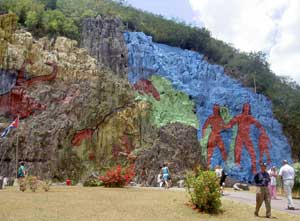
A two hour drive westward and we were parked under the largest mural in Cuba. The huge 120 m (394 ft) high and 180 m (590 ft) wide Mural de Prehistoria, is an imposing mural painted on a cliff by Leovigildo Gonzalez, a native of the valley.
He painted it as a tribute to aboriginal culture and represents the evolution of native life in this part of Cuba. A well-organized tourist stop, it offered all the modern amenities in an appealing setting.
After dining at the foot of the mural, on Cuban food in a tourist restaurant, we left to drive through the Viñales Valley – an area of some 152 sq km (59 sq mi) dotted with limestone green-covered hills.
After a ten-minute drive we stopped at a tobacco farm where a farmer was drying his leaves in a tobacco shed. During our tour, as I mistakenly walked through his living room, I said, “Pardoneme! Excuse me!”
The owner quickly replied, “Mi Casa is su casa! (My home is your home.)”

I turned back saying, “This expression comes directly from the Arabic, al-bayt baytak. ” I did not know what he thought but I had given my history lesson for the day.
The countryside as we drove onward passed edging fields covered with tobacco and taro and yucca – delicious tubers much loved by the Cubans. Our drive led to the town of Viñales, a gem of a tiny urban center which some say is the best place in Cuba to live.
The inhabitants keep their homes spick and span thanks to the income made renting rooms to tourists who are usually glad to live with a Cuban family in the midst of seductive surroundings.
A Mystic Aura
Continuing our journey, a short distance away we stopped at the Mirador de los Jazmines on a high point, 160 km (100 mi) from Havana, overlooking the Valle de Viñales below. Standing on an observation point edged by the Hotels Los Jazmines, I gazed on the enchanting valley, all green with a mystic-like aura.
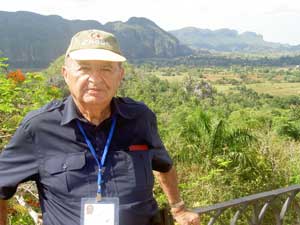
The scenery across the valley floor had a dreamlike character. High, mostly green-clad cliffs enclosed a valley of green farmland with a sprinkling of palms, here and there an outcropping of rock, seemingly planted to break up the all-encompassing greenery.
It was a wistful scene of how nature without a brush can bring out the beauty, even without a painter, to create a Shangri-la.
As I pulled myself away from this stunning scene, I heard a woman say, “Oh for the life of a dog!” Looking down, I saw a dog curled up and lazing in the sun, oblivious to the world around it.
Traveling in Cuba I have always been amazed at how often one sees dogs sleeping under the blazing sun, disregarding human traffic and the searing heat.
A Fire-Fighting Tree
Back on our return journey, we were soon making our way on a winding road through the wooded Mogotes Mountains. As we drove along, our guide pointed out and described the various trees by the wayside.
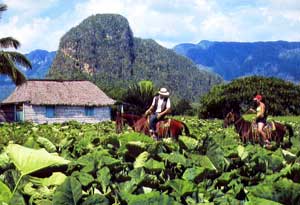
Among these was the almasigo, used to cure stomach problems and the hicacos that carry water in its trunk and acts as a fire deterrent. In the words of my seat companion, “the Cubans know how not to work. They let the trees fight the fires for them.”
Turning on the main road we drove in the shadows of hills to our left looking like pincushions – some large, some small.
The countryside appeared to be a rich rural area with neat looking homes amid fields of banana, sugarcane and a host of other agricultural produce, dominated by and dotting the landscape, the majestic royal palm – the national tree of Cuba.
In this green aura, it seemed that every second farm had small herds of cattle grazing on the rich foliage.
After our two-hour journey return journey to Havana, satisfied, I thought of the Complejo Las Terrazas and Valle de Viñales, which my acquaintances had described as ‘Cuba’s Shangri-la.’
I felt that indeed I had visited for the second time Shangri-la and its pathways – truly a trip well worthwhile.

Facts to Know About Cuba:
[Editor’s note: US citizens who wish to visit Cuba must obtain a license from the US Treasury’s Office of Foreign Assets Control.]
1) Cuba has become for tourists much more expensive. It is best to take an all-inclusive package offered by most hotels.
2) For transportation, in Havana take taxis. They are the best way to get around. Rental cars are expensive – around 50 to 80 CUC (convertible pesos) a day and up and gas is around.75 CUC a liter.
3) In spite of the shortages, all of Cuba is still safe, thefts are rare and tap water is drinkable, even in the villages. However, for tourists to feel safe, they should drink bottled water, found everywhere.
4) The best buys in Cuba are rum and cigars. Beware of black market cigars – often they are not authentic. Seven-year-old Havana Club is the top rum in Cuba. It is smoother than brandy and sells at around 12 CUC a bottle. In Havana, the best place to buy Cuban souvenirs is at Handicraft Markets like the one near Plaza de la Catedral.
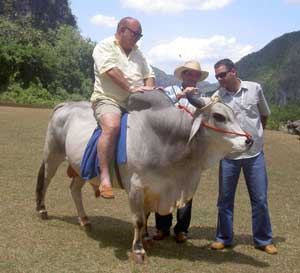
5) Cubans are appreciative of gifts, especially soap, English-Spanish dictionaries and all types of clothing – new and used.
6) The best time to travel to Cuba is from December to the end of April during the dry cool season.
7) Remember to keep 25 CUC for the departure tax.
Currency:
Visitors to Cuba must use convertible pesos (CUC – at present 1 CUC = $1.10 Canadian or.70 Euro). The Cuban peso, which can only be used by tourists to purchase such products as fruit and vegetables, converts at about 1 CUC to 25 pesos. For Cuban currency information, visit this website.
Food:
Food in most ordinary Cuban restaurants is quite dull. An average meal for tourists costs from 12 to 15 CUC. Visitors should try the main Cuban dish, rice and black beans – very tasty if spiced.
Some good restaurants to try while in Havana are: Floridita Restaurant, famous as Hemingway’s haunt; Eljibe Restaurant, serving large groups; Yeasmin Restaurant, noted for its Arabic food; and for the epitome of meals try Hotel Nacional where for about 60 CUC the best food in town can be had.
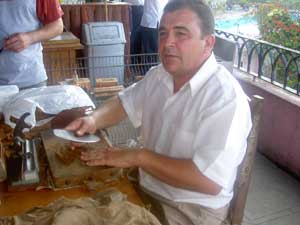
Entertainment:
Havana’s most renowned nightspot is La Tropicana built in a grotto of royal palms. It features a spectacular extravaganza of lavish scenery, dancing and sumptuous costumes – cost 65, 75 or 85 CUC, depending on the seat. However, there are other cabarets like the Parisian at the Nacional Hotel that costs about half the price of El Tropicana.
Note: All the prices quoted are in CUC pesos.
For further information, contact:
Cuba Tourist Board
Toronto: 1200 Bay Street. Suite 305. Toronto. ON. M5R 2A5. Tel: (416) 362-0700. Toll-Free: 1-866-404 CUBA (2822). Fax: (416) 362-6799 e-mail:
Montreal: 2075, rue University, Bureau 460 Montréal, Québec, H3A 2L1 Tel: (514) 875-8004 Fax: (514) 875-8006 e-mail, website: gocuba.ca
- El Salvador: Mayan Ruins and Scenic Landscapes - January 14, 2022
- Enchanted in Jarabacoa, Dominican Republic - March 5, 2019
- Ugarit, Syria: The Place Where Alphabets Began - September 26, 2017


